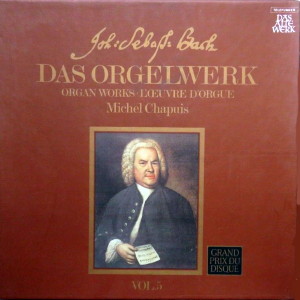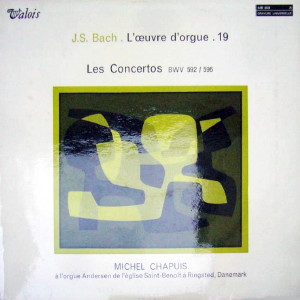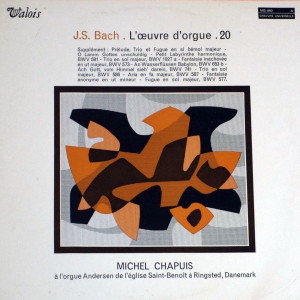 |
|
2 LP's
- BC 25102-T/1-2 - (p) 1970
|

|
| 1 LP -
Valois MB 859 - (p) 1970 |
 |
| 1 LP -
Valois MB 860 - (p) 1970 |
|
| DAS ORGELWERK -
VOL. 5 |
|
|
|
|
|
| Johann
Sebastian Bach (1685-1750) |
|
|
|
|
|
| Long Playing
1 - (Valois MB 859) |
|
|
| Konzert a-moll,
BWV 593 - nach Vivaldi |
11' 19" |
|
| Konzert C-dur,
BWV 595 - nach Prinz Johann Ernst
von Sachsen-Weimar |
4' 20" |
|
| Konzert
d-moll, BWV 596 - nach Vivaldi |
10' 14" |
|
|
|
|
| Konzert
C-dur, BWV 594 - nach Vivaldi |
19' 34" |
|
| Konzert
G-dur, BWV 592 - nach Prinz
Johann Ernst von Sachsen-Weimar |
6' 43" |
|
Long Playing
2 - (Valois MB 860)
|
|
|
| Präludium,
Trio und Fuge B-dur, BWV 545b |
10' 52" |
|
| O
Lamm Gottes, unschuldig |
4' 33" |
|
| Kleines
harmonisches Labyrinth C-dur,
BWV 591 |
4' 01" |
|
| Trio
G-dur, BWV 1027a |
3' 13" |
|
| Fantasie
C-dur, BWV 573 (unvollendet) |
1' 06" |
|
|
|
|
| An
Wasserflüssen, Babylon,
BWV 653b |
5' 46" |
|
| Ach
Gott, vom Himmel sieh' darein,
BWV 741 |
4' 08" |
|
| Trio
G-dur, BWV 586 - von
Telemann |
2' 00" |
|
| Aria
F-dur, BWV 587 - von
François Couperin |
3' 21" |
|
| Fantasie
c-moll (anonym) |
2' 35" |
|
| Fuga
G-dur, BWV 577 |
2' 08" |
|
|
|
|
| Michel Chapuis |
|
| an
der Andersen-Orgel der
St. Benedikt-Kirche,
Ringsted/Dänemark |
|
|
|
|
|
Luogo
e data di registrazione |
|
Ringsted
(Danimarca) - agosto 1970 |
|
|
Registrazione: live /
studio |
|
studio |
|
|
Producer / Engineer |
|
Michael
Bernstein |
|
|
Prima Edizione LP |
|
- Valois
- MB 859 · Vol. 19 - (1 LP) -
durata 52' 10" - (p) 1970 -
Analogico
- Valois - MB 860 · Vol. 20 - (1
LP) - durata 43' 43" - (p) 1970 -
Analogico
|
|
|
"Das Orgelwerke" LP |
|
Telefunken
- BC 25102-T/1-2 - (2 LP's) -
durata 52' 10" / 43' 43" - (p)
1970 - Analogico |
|
|
Note |
|
- |
|
|
|
|
|
The present
album comprises Bach’s five
organ concertos based on
others’ instrumental
concertos, as well as a
series of miscellaneous
pieces, individual choral
arrangements, trios,
fantasias and fugues of
varying worth and in some
cases of disputed origin. It
thus provides a glance into
an aspect of Baroque organ
practice which as a rule
receives too little
attention when seen from the
usual point of view: the
daily organ practice with
which the organist extends
his repertoire and becomes
acquainted with the new
styles and those of others.
- The share of the arranger
in the new designing of
these works could be
extremely varied: from the
simple text book style
transcription to the
complete reorganization and
fresh creation on the basis
of the old material there
are all the stages of
appropriation. With such a
system of working the
question as to author also
becomes hazy. The old
manuscripts very often fail
to mention the composer of
the original work - he was
in any event known to the
initiated - and designate
the work by the name of the
arranger. Thus, among the
works ascribed to Bach, one
or the other will no doubt
turn out to be the
arrangement of another’s
piece. - The solo concerto
was eminently suitable for
such arrangements. The
Venetian violinist Antonio
Vivaldi (1678-1741) had
within a few years developed
it into a leading
instrumental genre of the
time. The principle of
concerto playing, the
changing of different sound
groups, the contrast between
tutti and solo, had already
been customary for about 100
years at that time. In the
concerti grossi of Corelli
and the solo concertos of
Torelli certain forms of
several-part instrumental
concerto had already taken
shape before 1700. It was
left to Vivaldi, however, to
create the new concerto type
that held the future. On the
pattern of the Neapolitan
opera sinfonia he had
reduced the number of
movements to three: two fast
outer movements and a slow
middle movement which was
mostly of a lamento
character and in uneven
tempo. The most important
element, however, was its
formal, harmonious and
thematic disposition of the
fast concerto movement. The
starting point is the
several-part tutti
ritornello with a spirited
opening movement, a
continuation in sequence and
cadenced epilogue. This is
followed in frequent change
by figurative solo passages
and shorter tutti, made up
of fragments of the
ritornello. The movement
usually ends with a free
repetition of the entire
ritornello. The compactness
of the movement is
reinforced by a clear
harmonic disposition, in
which the main functions of
the major-minor tonality are
exploited to the full. The
solos modulate while the
tutti strengthen the
particular key. The thematic
pithiness and the thrilling
action of these movements
would be inconceivable
without the singilarly new,
sharply accentuated tempo
rhythm and the clearly
jointed dominant cadences.
Five Concertos based on
Various Masters (BWV
592-596) (a sixth, BWV
597, is only weakly
authenticated). Vivaldi’s
concertos became quickly
known in the German
residences and were
frequently copied. Bach had,
during his Weimar organist
and concertmaster period -
like his cousin Johann
Gottfried Walther who was
active there - transposed a
large number of such
concertos to the piano and
to the organ. The organ
inevitably was particularly
suitable for concerto
arrangements of this kind;
by way of alternation
between the swell-organ or
organo pleno and Rückpositiv,
the organist was capable in
perfect manner of depicting
the contrast among the
various concerto
instrumental groups, the
change from tutti and solo.
Bach’s aim with these
arrangements was to
transpose the original
composition as faithfully as
possible to the new
instrument. Here and there
he complemented a
counterpoint, enriched the
harmony and adapted the
figuration to the
performance technical
conditions of the organ. On
the whole, however, he
refrained from interference
with the score, and
apparently did his best to
produce no more than a
“keyboard excerpt” of the
original.
1) Concerto A minor based
on Vivaldi, BWV 593.
Vivaldis’ A minor concerto
for two violins and strings
op. 3, No. 8 (Estro
armonico), that is
transposed here, is one of
the outstanding pieces among
over 400 concertos composed
by the Venetian master. The
first movement in particular
fulfills all the demands
that were made upon a modern
concerto movement: a long,
several-part ritornello with
a spirited introductory
subject at the beginning,
richly alternating solo
passages which do not
content themselves with
figurations but develop
their own themes, a return
of the entire ritornello in
extended form at the
conclusion. The adagio in D
minor and in 3/4
time provides the expressive
contrast. It is constructed
above a bass figure which
introduces and concludes the
movement in ritornello
style, and quasi ostinato,
abridged in part, retains it
throughout the whole
movement. The final allegro,
which again is built up in
the concerto movement form,
also differs in character
and in tempo (3/4)
from the first allegro. The
ritornello is more
compressed, the solos are
more expansive.
2) Concerto C major based
on Johann Ernst von
Sachsen-Weimar, BWV 595.
The two music loving Weimar
princes, Ernst August and
Johann Ernst, were diligent
pupils of Johann Gottfried
Walther. The younger, Johann
Ernst, who died in 1715 at
the age of nineteen,
composed a series of solo
concertos on the Italian
pattern, some of which were
also published. Bach, who
was on friendly terms with
the gifted princes, arranged
some of the concertos for
the piano and organ. The
present organ arrangement
contains only the first
movement of a three-movement
concerto - although
considerably extended - the
other movements of which
have been handed down to us
solely in the piano
arrangement also by Bach,
BWV 984.
3) Concerto in D minor
based on Vivaldi, BWV 596.
This work, which is
available in a manuscript by
Johann Sebastian Bach, was
for a long time thought to
be a composition by his son
Wilhelm Friedemann. It was
only later discovered that
it was the arrangement of
the D minor Concerto No. 11
from Vivaldi’s op. 3; even
later it transpired that the
arrangement originated from
Johann Sebastian Bach
himself. Before the aged
Wilhelm Friedemann sold his
father’s manuscript he wrote
across the piece: “di W. F.
Bach, manu mei Patris
descriptum” (“by W. F. Bach,
copied by the hand of my
father”). It is difficult to
imagine what induced him to
carry out this forgery; for
the purchaser, Johann
Nikolaus Forkel, must have
been far more interested in
a work by Johann Sebastian
Bach than a composition by
his son. Judging by its
formal style, the work
accords more with the
concerto grosso of the
Corelli character than the
modern solo concerto. The
instrumentation of the
original, which confronts
the “grosso” with the
soloist “concertino”
consisting of two violins
and cello, points in this
direction.
4) Concerto C major based
on Vivaldi, BWV 594.
The organ arrangement is
evidently based upon an
earlier version of the
violin concerto D major
distributed in manuscript
form, published in 1717 as
No. 5 of the second
instalment of op. 7. The
recitative middle movement
was exchanged in the printed
version for another.
Compared to the A minor
concerto op. 3, No. 8
referred to above, the
dimensions have considerably
expanded, particularly of
the soloist sections, and
the virtuosity is greatly
enhanced. Departing from
custom, the first movement
waives the return of the
complete ritornello at the
conclusion, the last fading
out into a long solo cadenza
with which the end is
considerably protracted.
5) Concerto G major based
on Johann Ernst von
Sachsen-Weimar, BWV 592.
The three-movement work,
which Bach also arranged in
addition for harpsichord
(BWV 592 a), despite all its
playful mood, clearly
reveals the difference from
its Italian pattern. It
lacks the generously
proportioned design, the
strength of the themes, the
singing quality of the
figuration. Nor is it up to
the standard of the
one-movement concerto
fragment by the prince
reproduced above, and it is
of interest only as a trial
piece by a gifted young
dilettante to whom Bach felt
an obligation.
Miscellaneous Works
1) Prelude, Trio and
Fugue B-flat major, BWV
545 b. The prelude and
fugue are already contained
in the known and authentic
version in C major (BWV 545)
in the III series of Bach’s
Organ Works. The present
version and movement
sequence originates from an
English manuscript from the
second half of the 18th
century, and is ascribed
there to the organist at
London’s Westminster Abbey,
John Robinson (1682-1762).
It was published for the
first time in 1959. After
the prelude (BWV 545 a,
transposed to B-flat major)
there follows, linked by a
short adagio movement, an
organ version of the trio
movement, which was
previously known to us only
as the finale of the sonata
for viola da gamba and
harpsichord G minor (BWV
1029). A short tutti theme
connects up with the fugue
BWV 545/2, which here, like
the prelude, is transposed
into B-flat major. The two
bridging movements probably
originate from Robinson. It
is uncertain whether Bach at
one time envisaged the trio
in this context; some
manuscripts provide the
prelude and fugue BWV 545
together with the slow
movement of the organ sonata
BWV 528.
2) O Lamm Gottes,
unschuldig. This
double chorale arrangement
by Bach did not become known
until the 1950’s.
The first version proceeds
in imitative style. The
second paraphrases the
chorale melody in the manner
of the so-called “Arnstadter
congregational chorales”, as
described more fully in the
second series of the Bach
Organ Works.
3) Little harmonious
Labyrinth, BWV 591.
When, around 1700 the even
tempered pitch of keyboard
instruments began to assert
itself, pieces came into use
which modulated through the
entire circle of fifths, or
at least aimed at roving
around in the keys with the
aid of enharmonic
alternations. The present
piece, which is hardly
likely to have been composed
by Bach, but rather by the
Dresden chapel master Johann
David Heinichen (1683-1729),
arranged the harmonic puzzle
game in three sections: the
overture-style “Introitus”,
the “Centrum”, in which a
chromatic theme is
introduced as a fugue, and
the slow “Exitus”.
4) Trio G major, BWV
1027a. The work, which
has been handed down in only
a single copy which gives
little cause for confidence,
consists of a short,
musically not very
convincing version of the
last movement of the sonata
for viola da gamba and
harpsichord BWV 1027 or of
the musically identically
sonata for two flutes and
continuo BWV 1039. As Ulrich
Siegele has shown, by and
large it is closer to the
flute version. Up to the
present day it has not been
clarified whether it is an
unskilful, non-authentic
arrangement of this version,
or a spoilt descendant of an
“original version” to which
the two sonata movements go
back.
5) Fantasia C major, BWV
573. Bach entered this
five-part fantasia, which
from its beginnings was to
be a large-scale work, in
the first piano book of his
wife Anna Magdalena in 1722.
Unfortunately it was not
completed. It breaks off bar
13 with the cadence at the
3rd degree.
6) An Wasserflüssen
Babylon, BWV 653 b.
Unlike the wellknown
four-part arrangement of
this chorale melody from the
“Eighteen Chorales” of the
later Leipzig period, this
five-part original version
is usually neglected. It is
scored throughout for double
pedal - and perhaps this
performance technique
speciality, which went out
of use among organists in
the first half of the 18th
century, was the reason for
the subsequent
rearrangement. This earlier
version
is certainly not inferior to
the later one as regards
beauty and stylistic art.
The heartpiece of the
movement is the second part
which repeats a plaintive
eight-bar melody formed from
the first two chorale lines
going through the entire
piece quasi ostinato.
7) Ach Gott, vom Himmel
sich darein, BWV 741.
This chorale arrangement by
the young Bach is marked by
tempestuous strength and
wealth of invention. From a
certain degree of stylistic
malauroitness,
which he later avoided and
which he also smoothed over
during a subsequent editing
of the work, we can conclude
that the composition still
emanated from the Arnstadt
period. The chorale melody
lies in the bass. It is
arranged line by line with
the usual “pre-imitation”;
the conclusion is
constructed as an
ingrisification by way of
canonic bearing of the two
last chorale lines in the
double pedal.
8) Trio G major by
Telemann, BWV 586.
Whether the adaptation of
this two-part Telemann
allegro for the organ really
originates from Bach is
uncertain. The gay,
extrovert movement is a
credit to its composer.
9) Aria F major by François
Couperin, BWV 587.
This piece is, almost note
for note and without any
changes indicating an
arrangement, the middle
section marked “Légerement”
from the Troisieme Ordre of
the Couperin trio sonatas
published in 1726 under the
title “Les Nations”. A copy
from the vicinity of Bach in
which the name of the author
was missing was the reason
for the false accreditation.
This, as well as the
previous piece, show that
one was capable of playing
as an organ trio on two
manuals and pedal,
frequently without any
alteration, movements from
trio sonatas for two melody
instruments and basso
continuo.
10) Fantasia C minor.
Max Seiffert published this
work for the first time. It
was handed down in the
so-called "Andreas Bach Book", a
collection of manuscripts
from the vicinity of Bach at
the beginning of the 18th
century, without any note as
to author and in German
organ tablature. Judging
from its strength of
combination, the excellent
work could certainly have
come from the young Bach.
11) Fugue G major, BWV
577. The mobile work
in gigue rhythm, which is
worthy of attention if only
because of the convincing
use of the pedal, is from
the point of view of origins
only weakly authenticated as
a Bach composition: from the
point of view of its style,
one could hardly deny that
it originated from the young
Bach.
by Georg
von Dadelsen
English
translation by
Frederick A. Bishop
This critical
and complete stylistic
survey of Bach's
organ works is
the fifht part
and will be
continued by
further
releases.
|
|
|
Johann
Sebastian Bach - DAS
ORGELWERK
|
|
|
|

